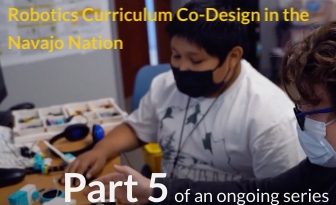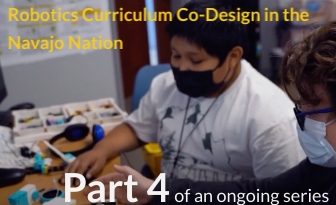Part 3: Discussing Challenges
This is part of a series that chronicles the ongoing collaboration between Tufts CEEO and Little Singer Community School in the Navajo Nation. Click here to view the whole series.
TL;DR: There were many different challenges we faced throughout this collaboration. They were logistical and technical in nature. Some of these issues have been resolved, while others remain for future exploration and engagement.
I want to start by acknowledging that we at the CEEO do not wish to take deficit-based approaches to our analyses of educational settings. Instead, I want to frame this as a presentation of the unique challenges that we faced during this project as an offering so that others may learn from our experiences.
In a pandemic where already nothing about the school year is “business as usual”, starting a project like the work Tom, Bill, and I were doing was definitely unique. While we certainly had a lot going for us (expert educators, an established online classroom and student group, funding and support from Tufts CEEO and the LEGO Foundation, etc.) we need to also identify and reflect on the many challenges we faced. These ranged from minor inconveniences to major roadblocks — some of which we are still figuring out how to get around. Generally, I think of the difficulties we faced as falling into one or both of two categories: logistical and technical.
Logistical
Anyone who works in education knows that quality curriculum and project ideas take time to develop, and time was definitely not something we had an abundance of. The project itself started quickly, so the three of us didn’t get much time to meet and plan before beginning to work with Tom’s class. On top of that, all three of us had full-time jobs to occupy us during the week, so while we all worked hard to prioritize meeting up for class time, it was very difficult to find time for us to meet up and make plans. Very often, we would end up having to meet very early in the morning (5am for Tom, in Arizona time!) before Tom began to teach for the day. We sometimes met on weekends too, which is not ideal. During these meetings, we were constantly playing catch up, because we had to split our already limited time between trying to reflect on what we were already doing and also plan for the next days and weeks. On the bright side, our engineering and science projects always took multiple days to complete, so it gave us some breathing room for coming up with what to do next.
Speaking of taking multiple days to run projects, figuring out the pacing of each activity was always a challenge. After a year of teaching robotics online, I already knew that anything we wanted to do was going to take far longer than if we’d been in-person in a classroom. But many of the technical and cultural challenges I’ll mention later ended up further extending the time it took to complete even basic tasks. In hindsight though, this isn’t the most terrible problem to have. While it meant that we couldn’t do as many of the projects we’d hoped to finish before the end of the school year, there was no real rush or pressure to do so. Yes, we were doing our best to align our content to Tom’s work in their math and science classes (mostly focusing on Newton’s laws of motion) but there was no expectation of a final “finish line”. This was the beauty of being in the very earliest stages of collaboration. For April and May, the three of us were simply trying to figure out ideas and methods that worked well, while delivering fun, engaging, and educational content to the students.
Hands-on engineering and robotics projects rely on the availability of materials and a space in which to work. Most of our students struggled with the logistical aspects of material and workspace access. Students had to work at home alongside family members, pets, and a myriad of other potentially distracting circumstances. They didn’t always have access to a broad, level surface upon which to build and test their devices. Because students lived very far apart on the Navajo reservation, it was a challenge to deliver kits and materials when they were needed.
The whole online experience was challenging both for technical and logistical reasons. We’ll touch upon the technical issues later, but in terms of simply organizing and running the activities for the students, there is much to talk about concerning doing things virtually rather than in person. Especially when teaching something that is so naturally hands-on and collaborative as robotics, working remotely with individual students has many challenges. When students have a technical issue with a component, diagnosing and fixing it relies on students being able to clearly communicate both visually and in words what is happening — which can be especially challenging for younger students. They may not even understand what is happening with their device, making describing the problem that much more frustrating. Additionally, it can be hard to give students exactly perfect instructions on how to hold a thing, what to touch or press, or how to accomplish a task when you can’t clearly see what’s going on. More than anything, the single most challenging aspect of running online instruction is that when a single student encounters a problem and needs specialized help, it can derail the entire class. In person, a teacher could be able to walk over to a student’s table and deliver quick, personalized aid while the rest of the class continues to work. In a zoom call, we learned to utilize breakout rooms and teaching assistants (always brought two undergraduates from Tufts to help!) to manage one-on-one needs while the lead educator stayed in the main room to keep working with the group. This process of using breakout rooms was effective, but is a considerable drain on time and teacher resources because it requires the presence of multiple teacher assistants. This model is unavailable for the average school teacher who does not have access to multiple TAs every day.
Technical
The biggest technical hurdle to overcome was internet connectivity — something that Tom and his students were dealing with for the entire school year. The remote locations and vast distances between families in this part of the Navajo Nation meant that simply making the connection to our zoom classroom was a challenge. Every student at Little Singer was provided with a chromebook and a standalone wifi hotspot device, but linking to an internet connection still proved difficult for many students.
A typical class session saw almost every student drop and re-join the call multiple times. Sometimes students missed whole sessions or even multiple days because they simply could not connect. Some students could never turn on their video because of weak connections, hindering the ability to visually check in on them and their work. Many students regularly had difficulty seeing and hearing the call clearly, meaning that oftentimes important instructions and explanations had to be repeated.
Whenever an educator would prompt the class (or an individual student) with a question or ask for feedback of any kind, we learned quickly that we had to provide a much longer than average wait time (which as we all know, teachers are bad at doing anyway — we’re always in a hurry to hear back from our students). When we got silence from the zoom gallery, it was so hard to tell if students had heard us at all, were trying to respond but couldn’t, or were simply balking at a response for any number of reasons.
Wrap Up
The challenges of conventional online teaching coupled with poor internet connectivity were the biggest factors that resulted in the slower pace of completing the engineering and science projects we wanted to do. These may very well be common conditions in many other regions of the world that we wish to bring into our Tech and Play work, and I am thankful that I’m getting experience with them alongside a veteran educator like Tom. He was able to guide me, Bill, and our TAs in having the patience and resourcefulness to work through these difficulties every day. In the end, making plenty of time to accommodate for these time sinks (scheduling more time for activities, explaining instructions multiple times and constantly checking for understanding, providing instructions in written format, and simply providing more wait time after prompting students) worked well and we got better at doing it as the weeks went on.




